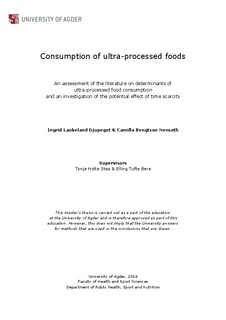| dc.contributor.author | Djupegot, Ingrid Laukeland | |
| dc.contributor.author | Nenseth, Camilla Bengtson | |
| dc.date.accessioned | 2016-10-05T11:15:29Z | |
| dc.date.available | 2016-10-05T11:15:29Z | |
| dc.date.issued | 2016 | |
| dc.identifier.uri | http://hdl.handle.net/11250/2413051 | |
| dc.description | Masteroppgave folkehelsevitenskap - Universitetet i Agder 2016 | nb_NO |
| dc.description.abstract | Background Highly processed foods have been classified as ultra-processed, and
consumption of such foodstuffs have expanded rapidly over the last decades. Ultra-processed
foods are characterized as being accessible, attractive, palatable and often time-saving. An
excess intake of ultra-processed foods has been associated with increased risk of e.g.
overweight/obesity and diabetes type II. The aim of this master’s project was to investigate
factors influencing consumption of ultra-processed foods. This resulted in one review paper
on young adults, and one cross-sectional study where the association between time scarcity
and ultra-processed food consumption was investigated.
Methods In order to identify relevant material for the review paper, a systematic literature
search was conducted in four databases, using a two-folded search string with terms indicative
of ultra-processed foods and determinants. The cross-sectional study included 497
participants. A validated score was used as an indicator of time scarcity, and three scores were
developed as indicators of ultra-processed food consumption; ultra-processed dinner products,
snacks & soft drinks, fast foods. Binary logistic regression analyses were used to investigate
the association between time scarcity and consumption of ultra-processed foods. Analyses
were adjusted for sociodemographic factors.
Results In total, 65 studies were included in the review paper, and the majority of these
investigated determinants on the individual level. Gender, younger age and more television
watching were associated with consumption of ultra-processed foods. The cross-sectional
study showed that participants with higher degree of time scarcity had higher odds of being
high consumers of fast foods. Regression analyses also showed sociodemographic differences
in consumption of ultra-processed foods.
Conclusions Future research should further investigate factors influencing consumption of
ultra-processed foods, particularly on the environmental level where there is currently a lack
of research. Intervention studies and studies with a longitudinal design are needed.
Keywords Ultra-processed food, processed food, determinants, time scarcity, young adults | nb_NO |
| dc.language.iso | eng | nb_NO |
| dc.publisher | Universitetet i Agder ; University of Agder | nb_NO |
| dc.subject | ultra-prosessert mat | nb_NO |
| dc.subject | prosessert mat | nb_NO |
| dc.subject | bearbeidet mat | nb_NO |
| dc.subject | determinanter | nb_NO |
| dc.subject | tidspress | nb_NO |
| dc.subject | unge voksne | nb_NO |
| dc.subject | ultra-processed food | nb_NO |
| dc.subject | processed food | nb_NO |
| dc.subject | determinants | nb_NO |
| dc.subject | time scarcity | nb_NO |
| dc.subject | young adults | nb_NO |
| dc.subject.classification | ME516 | |
| dc.title | Consumption of ultra-processed foods : an assessment of the literature on determinants of ultra-processed food consumption and an investigation of the potential effect of time scarcity | nb_NO |
| dc.type | Master thesis | nb_NO |
| dc.subject.nsi | VDP::Medical disciplines: 700::Health sciences: 800::Nutrition: 811 | nb_NO |
| dc.source.pagenumber | [115] s. | nb_NO |
